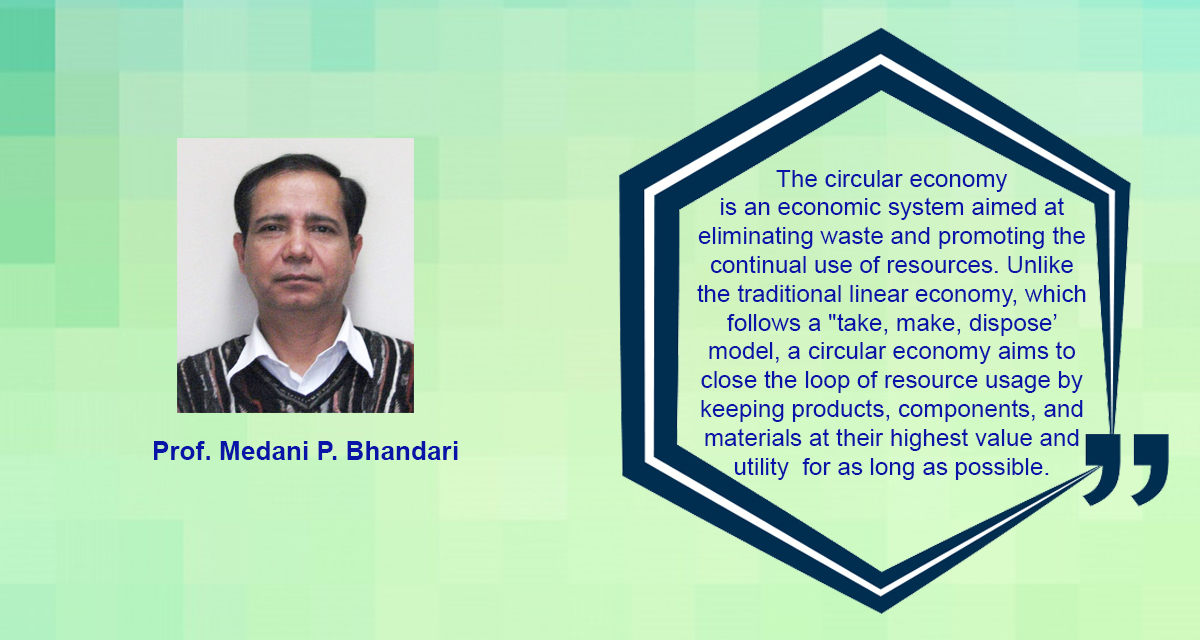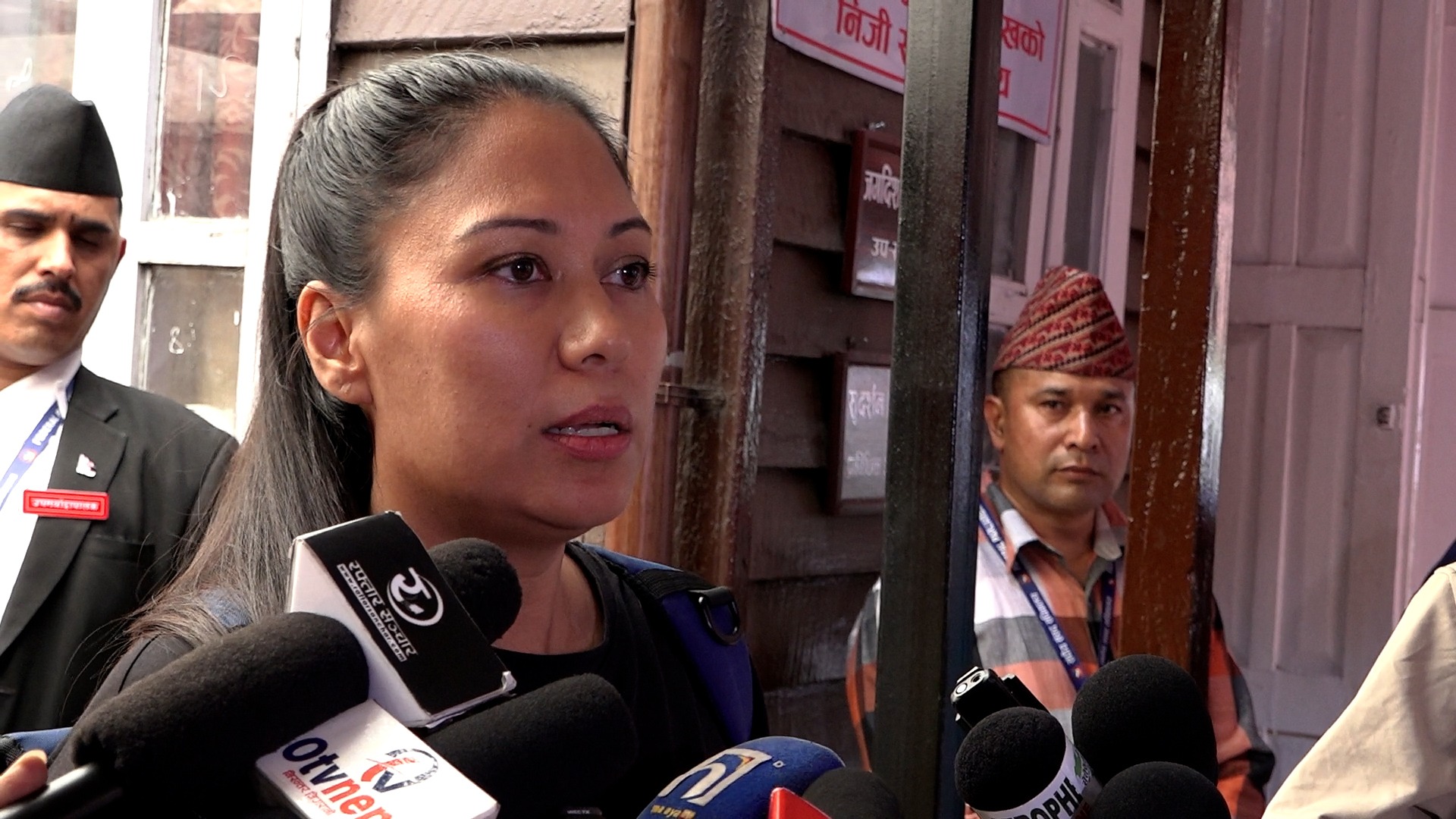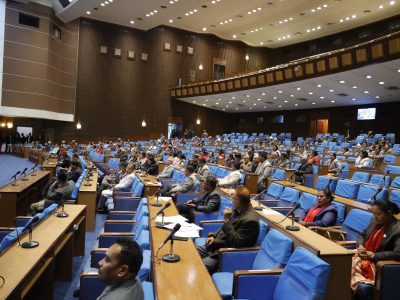Embracing Circularity: The Key to Sustainable Living in the 21st Century

In this paper, I have tried to provide a theoretical overview of the circular economy and its leading principles in the context of sustainable development. Drawing upon insights from development economics and socio-economic development theory, this opinion piece seeks to elucidate the fundamental importance of embracing circularity as a pathway towards sustainable livelihoods.
The circular economy operates on the foundational principles of designing for longevity and recyclability, optimizing resource usage, and promoting system-wide innovation. These principles, deeply rooted in sustainability theory, advocate for a paradigm shift away from the linear “take-make-dispose” model towards a regenerative approach where resources are continually reused, recycled, and repurposed. By emphasizing the importance of extending product lifecycles, minimizing waste, and maximizing resource efficiency, the circular economy offers a holistic framework for addressing pressing environmental challenges while fostering economic prosperity and social equity.
At its core, this paper underscores the interconnectedness between economic development, environmental sustainability, and social well-being. It posits that embracing circularity is not merely a matter of environmental stewardship but a fundamental imperative for achieving sustainable development goals. By adopting a circular economy mindset, societies can transition towards more resilient and inclusive economic systems that prioritize the needs of both present and future generations.
Furthermore, this paper advocates for the widespread adoption of circular economy principles across various sectors and scales of operation. From individual consumption habits to corporate strategies and government policies, the integration of circularity into everyday practices holds the potential to catalyze transformative change toward a more sustainable future.
In conclusion, this paper serves as a call to action for all stakeholders to embrace the principles of circularity and apply them in their respective spheres of influence. By collectively embracing circularity as a guiding principle, we can pave the way toward a more sustainable and equitable world for all.
The circular economy is an economic system aimed at eliminating waste and promoting the continual use of resources. Unlike the traditional linear economy, which follows a “take, make, dispose’ model, a circular economy aims to close the loop of resource usage by keeping products, components, and materials at their highest value and utility for as long as possible. This concept is based on sustainability and resource efficiency principles, which seek to decouple economic growth from the consumption of finite resources.
A circular economy operates according to three main principles:
Design for longevity and recyclability: Products are designed to last longer, be easily repairable, and disassemble or recycle at the end of their life cycle. This design approach minimizes waste and ensures that materials can be reintroduced into the production process.
Optimize resource usage: Resources are managed to maximize their value and minimize waste generation. This involves strategies, such as reusing, remanufacturing, refurbishing, and recycling materials and components to keep them in circulation for as long as possible.
Promoting system-wide innovation: The circular economy encourages innovation across the entire value chain, from product design and manufacturing to distribution, consumption, and disposal. This includes developing new business models such as product-as-a-service and sharing platforms, extending product lifetimes, and optimizing resource utilization.
The key components and practices of a circular economy include the following.
Closed-loop systems: Materials and products are circulated within closed loops, where waste and by-products from one process become inputs to another. This minimizes the extraction of virgin resources and reduces environmental pollution.
Resource recovery and recycling: Emphasis is placed on recovering and recycling materials from products at the end of their life cycles. This involves implementing efficient recycling processes and infrastructure as well as investing in technologies that enable the recovery of valuable materials from waste streams.
Product-as-a-service (PaaS) models: Instead of owning products outright, consumers can access them as services and pay for usage, rather than ownership. This encourages manufacturers to design products for durability and reusability as they retain ownership and responsibility for maintenance and end-of-life disposal.
Sharing platforms and collaborative consumption: Sharing platforms facilitate the sharing and reuse of assets such as vehicles, tools, and accommodation among multiple users. This optimizes resource usage and reduces overall demand for new products.
Remanufacturing and refurbishment: The used products are restored to their original condition or upgraded to extend their lifespan. This practice reduces the need for new manufacturing and conserves resources by maintaining products in use for longer periods.
Waste reduction and prevention: Efforts have been made to minimize waste generation at the source through measures such as lean production, product design optimization, and the use of renewable materials.
The transition to a circular economy requires collaboration among businesses, governments, consumers, and other stakeholders to overcome various challenges, including technological barriers, regulatory frameworks, and cultural attitudes towards consumption and ownership. However, the potential benefits of a circular economy are significant, including a reduced environmental impact, enhanced resource security, and economic opportunities through innovation and job creation.
The Importance of Circular Economy to Obtain the SDGs
The circular economy plays a pivotal role in achieving the Sustainable Development Goals (SDGs) by offering a comprehensive framework for sustainable development. The circular economy is crucial for advancing the SDGs:
Resource Efficiency: A circular economy minimizes resource extraction and waste generation by promoting reuse, recycling, and remanufacturing. This approach ensures efficient use of natural resources, contributing to SDG 12 (Responsible Consumption and Production) by reducing resource consumption and waste generation.
Economic Growth: The circular economy creates new economic opportunities by promoting innovative business models and value chains. By fostering entrepreneurship and job creation, it contributes to SDG 8 (Decent Work and Economic Growth) and SDG 9 (Industry, Innovation, and Infrastructure).
Climate Mitigation: By reducing reliance on finite resources and minimizing greenhouse gas emissions associated with production and disposal, the circular economy helps combat climate change. This aligns with SDG 13 (Climate Action) by reducing carbon footprints and promoting sustainable practices.
Social Inclusion: Embracing a circular economy can enhance social equity by providing affordable access to goods and services, fostering community engagement, and promoting inclusivity in decision-making processes. This supports SDG 10 (Reduced Inequalities) and SDG 11 (Sustainable Cities and Communities).
Biodiversity Conservation: By reducing pressure on ecosystems and habitats through sustainable resource management, the circular economy contributes to the preservation of biodiversity, aligning with SDG 15 (Life on Land).
Waste Reduction: A circular economy minimizes waste generation by designing products for longevity, reuse, and recycling. This contributes to SDG 6 (Clean Water and Sanitation) by reducing pollution and protecting water resources from contamination.
Sustainable Consumption and Production: Emphasizing the principles of reducing, reuse, and recycling, the circular economy promotes sustainable consumption and production patterns, essential for achieving SDG 12.
The circular economy offers a holistic approach to sustainable development, addressing economic, social, and environmental challenges simultaneously. By aligning with the SDGs, it provides a roadmap for creating a more resilient, equitable, and prosperous future for all.
I conclude, that in the quest for sustainable living in the 21st century, embracing the principles of a circular economy emerges as a paramount strategy. Rooted in three fundamental principles—design for longevity and recyclability, optimization of resource usage, and promotion of system-wide innovation—the circular economy model stands as a beacon of hope for addressing pressing environmental concerns while fostering economic prosperity.
At its core, the circular economy advocates for a shift from the traditional linear “take-make-dispose” model to one that prioritizes closed-loop systems, where resources are continuously reused, recycled, and regenerated. This entails designing products and systems with longevity and recyclability in mind, ensuring that materials remain in circulation for as long as possible. Additionally, optimizing resource usage minimizes waste and maximizes efficiency, thereby reducing the strain on finite resources and mitigating environmental degradation.
Key components and practices of a circular economy include closed-loop systems, where waste is minimized through reuse and recycling, and resource recovery processes are implemented to extract value from discarded materials. Product-as-a-service (PaaS) models encourage a shift from ownership to access, promoting the sharing of resources and reducing overall consumption. Sharing platforms and collaborative consumption further facilitate resource-sharing among communities, promoting efficiency and reducing the environmental footprint of production and consumption.
Remanufacturing and refurbishment breathe new life into existing products, extending their lifespan and reducing the demand for new materials. Waste reduction and prevention strategies, such as composting and innovative packaging designs, minimize the generation of waste and contribute to a more sustainable future.
The significance of embracing a circular economy extends beyond environmental stewardship—it is intrinsically linked to the achievement of the United Nations Sustainable Development Goals (SDGs). By promoting responsible consumption and production, fostering innovation, and enhancing resource efficiency, the circular economy contributes to the realization of multiple SDGs, including those related to climate action, responsible consumption, and sustainable cities and communities.
In essence, embracing the principles and practices of a circular economy is not only essential for mitigating the environmental challenges of our time but also holds the key to fostering a more equitable, prosperous, and sustainable future for generations to come.
Facebook Comment
latest Video
Trending News
- This Week
- This Month
















